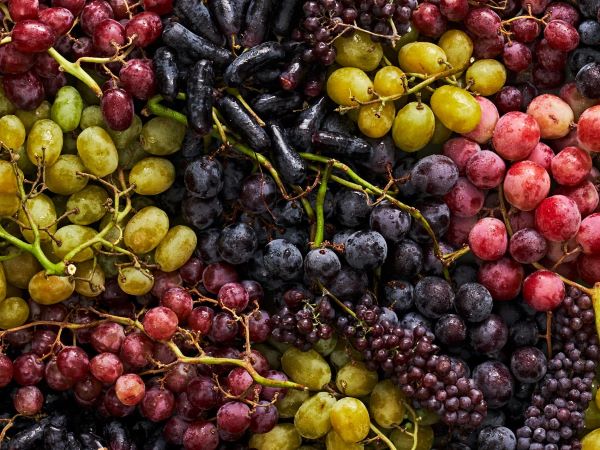Grapes are a popular fruit in India, known for their sweet taste, nutritional benefits, and versatility. India grows a variety of grape types, each with distinct characteristics, origins, and growing regions. In this article, we explore some of the most notable grape varieties in India, including their origins, history, where they are found, availability, and unique properties.
Contents
1. Thompson Seedless
- Origin: Iran (Persia)
- History: Introduced to India from Iran, this variety has become the most popular seedless grape in the country.
- Found in: Maharashtra, Karnataka, and Tamil Nadu
- Availability: January to May
- Unique Property: Known for its sweet taste and seedless nature. It is versatile and can be consumed fresh, dried (as raisins), or used in juices and wines.
2. Bangalore Blue
- Origin: India
- History: A native variety of Bangalore, it has been cultivated for over 150 years.
- Found in: Karnataka (particularly in and around Bangalore)
- Availability: April to June
- Unique Property: Known for its unique foxy flavor and deep blue color. Primarily used for making wine, juice, and jams.
3. Anab-e-Shahi
- Origin: India
- History: A traditional Indian variety, widely grown for its large berry size and sweetness.
- Found in: Andhra Pradesh, Karnataka, and Maharashtra
- Availability: April to June
- Unique Property: Known for its large, juicy berries and sweet flavor. It is often consumed fresh or used in fruit salads.
Also, read: Health Benefits of Amla: Science, Research, and Facts
4. Flame Seedless
- Origin: USA
- History: Introduced to India in recent decades and has gained popularity for its taste and seedless nature.
- Found in: Maharashtra and Karnataka
- Availability: February to May
- Unique Property: Known for its bright red color, crisp texture, and sweet flavor. Ideal for fresh consumption and salads.
5. Sharad Seedless
- Origin: India
- History: Developed by Indian agricultural scientists, this variety is popular for its seedless nature and high yield.
- Found in: Maharashtra and Karnataka
- Availability: April to June
- Unique Property: Known for its sweet taste, elongated berries, and seedless nature. Suitable for fresh consumption and drying as raisins.
6. Black Corinth (Zante Currant)
- Origin: Greece
- History: Introduced to India from Greece, primarily grown for making currants.
- Found in: Tamil Nadu and Andhra Pradesh
- Availability: April to June
- Unique Property: Known for its small size and intense sweetness. Used mainly for drying into currants.
7. Red Globe
- Origin: USA
- History: Introduced to India for its attractive appearance and large berry size.
- Found in: Maharashtra, Karnataka, and Tamil Nadu
- Availability: January to April
- Unique Property: Known for its large, round berries with a sweet taste. Consumed fresh and used in fruit arrangements.
Also, watch web stories: What Foods are Best for your Eye Health?
8. Sonaka Seedless
- Origin: India
- History: A popular variety developed by Indian farmers for its high yield and seedless nature.
- Found in: Maharashtra and Karnataka
- Availability: March to June
- Unique Property: Known for its elongated berries, sweet taste, and seedless nature. Ideal for fresh consumption and drying as raisins.
9. Concord
- Origin: USA
- History: Introduced to India from the USA, it is known for its distinctive flavor.
- Found in: Karnataka and Maharashtra
- Availability: March to May
- Unique Property: Known for its dark blue color and unique foxy flavor. Used in juices, jams, and wines.
10. Pusa Navrang
- Origin: India
- History: Developed by the Indian Agricultural Research Institute (IARI) as a hybrid variety.
- Found in: Maharashtra and Karnataka
- Availability: March to May
- Unique Property: Known for its attractive appearance, with a mix of red and black berries on the same bunch. Used for fresh consumption and juices.
Nutrition Chart of Grapes
Grapes are not just delicious but also packed with essential nutrients. Here’s a general nutritional profile of grapes per 100 grams:
| Nutrient | Amount |
|---|---|
| Calories | 69 kcal |
| Carbohydrates | 18.1 g |
| Sugars | 15.5 g |
| Dietary Fiber | 0.9 g |
| Protein | 0.7 g |
| Fat | 0.2 g |
| Vitamin A | 3 µg |
| Vitamin C | 10.8 mg |
| Vitamin E | 0.2 mg |
| Vitamin K | 14.6 µg |
| Potassium | 191 mg |
| Magnesium | 7 mg |
| Phosphorus | 20 mg |
| Folate | 2 µg |
| Calcium | 10 mg |
| Iron | 0.4 mg |
| Zinc | 0.1 mg |
| Thiamine (B1) | 0.1 mg |
| Riboflavin (B2) | 0.1 mg |
| Niacin (B3) | 0.2 mg |
| Vitamin B6 | 0.1 mg |





